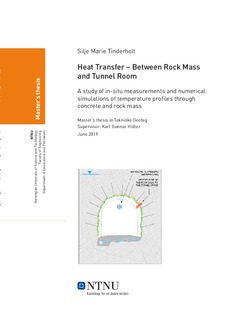| dc.contributor.advisor | Holter, Karl Gunnar | |
| dc.contributor.advisor | Næss, Erling | |
| dc.contributor.author | Tinderholt, Silje Marie | |
| dc.date.accessioned | 2019-09-28T14:00:47Z | |
| dc.date.available | 2019-09-28T14:00:47Z | |
| dc.date.issued | 2019 | |
| dc.identifier.uri | http://hdl.handle.net/11250/2619236 | |
| dc.description.abstract | Bruk av tunnelkledning uten frostsikring er en økende trend, spesielt i jernbane tunneler. Dette er metoder som er lite brukt i Norge tidligere, og dermed er det også minimalt med kunnskap om hvordan kledningen faktisk fungerer over tid. Siden kledningen ikke er frostsikret, slik de tradisjonelle kledningene er, er det et spesielt behov for å øke kunnskapen om hvordan lufttemperaturen i tunnelen påvirker temperaturen i både kledningen og bergmassen når den faller under null grader celsius. Ulvintunnelen og Gevingåstunnelen er bygget med henholdsvis plass-støpt betonghvelv, og fiberarmert sprøytebetong med sprøytbar membran. Disse to tunnelene er begge instrumentert med måleutstyr, som måler blant annet luft-, betong og bergmasse temperaturen.
Temperaturmålinger fra tre sesonger for begge tunnelene er presentert. Temperaturen i bergmassen og betongen faller ikke under null grader på noe tidspunkt i disse sesongene, målingene er tatt 1100m fra portalen.
De termofysiske egenskapene til Metasandsteinen som Gevingåstunnelen er drevet igjennom er testet. Målingene viser at konduktiviteten er høyest parallelt med foliasjonen. Prøvestykkenes mineral sammensetning ble også testet, dette viste at foliasjonen mest sannsynlig består av glimmer. Det høye kvartsinnholdet i prøvestykkene, forklarer den relativt høye termiske ledningsevnen til bergarten.
En COMSOL modell er validert både ved å benytte et laboratorieforsøk og in-situ målinger. Forsøket i laboratoriet foregår under kontrollerte omgivelser, slik at sammenligningsgrunnlaget med en numerisk modell er optimalt. In-situ er den numeriske modellen sammenlignet med målingene fra Gevingåstunnelen. Alle de numeriske modellene er en-dimensjonale, geometrien er laget slik at den skal gjenspeile en linje gjennom betongkledningen og innover i fjellet. Et Parameter Estimering studie er gjennomført for å undersøke hvilke parameter den numeriske modellen er sensitiv ovenfor. Analysen kom ikke frem til en entydig sensitiv parameter, men viste viktigheten av å ha kontroll over grensebetingelsene i modellen.
To ekstreme temperaturbelastnings senarioer er simulert ved bruk av den validerte Gevingåsmodellen, dataen i senarioene er hentet fra en målestasjon ved Værnes. Simuleringen viste at en uisolert tunnel eksponert for en vinter med 72 påfølgende dager med temperaturer under null gradersius, ga minusgrader inntil 2.5m fra tunneloverflaten. | |
| dc.description.abstract | Increasing utilization of bounded uninsulated lining systems in tunnels, and especially in rail tunnels, triggers the need for more information about how the bounded lining types functions during operation. Knowledge about how the air inside the tunnel influences the rock mass in an uninsulated tunnel is of great importance, especially when the temperature in the tunnel drops below zero degrees Celsius. Two tunnels are built with a bounded lining system and instrumented so that the temperature in the lining and adjacent rock mass can be logged. The Ulvin and the Gevingås Tunnel, constructed with respectfully a cast-in-place concrete lining, and a sprayed concrete and membrane structure.
The measurements from three succeeding winter seasons, from both tunnels, are presented. The data shows that at 1100m into the tunnel, the temperature in the rock mass does not drop below zero degrees Celsius in any of the winter seasons.
The thermophysical properties of the Metasandstone which the Gevingås Tunnel is built through are tested, along with the mineral composition of the rock. The measurements showed that the thermal conductivity is the highest parallel to the foliation, the foliation is most likely composed of mica. The high content of quartz explains the high effective conductivity of the rock mass.
A COMSOL model is validated by utilizing both laboratory measurements and in-situ analysis. The laboratory for this project is a controlled environment, used to test the rock mass response to temperature loads. The in-situ analysis is based on the measurements from the Gevingås Tunnel. All the models used are primarily one-dimensional, built to illustrate the concrete and rock mass inward from the tunnel wall. A parameter estimation study is performed, to see which of the parameters the model is most sensitive towards, the study did not provide one unambiguous sensitive parameter but shows that control over the boundary conditions is the most important.
Two worst case scenarios are based on external temperature measurements from Værnes. The most extreme winter had 72 following days with temperatures below zero degrees Celsius. Using this as the external temperature in a numerical model, resulted in temperatures under zero degrees Celsius, up to 2.5m inward from the exposed surface. | |
| dc.language | eng | |
| dc.publisher | NTNU | |
| dc.title | Heat Transfer – Between Rock Mass and Tunnel Room | |
| dc.type | Master thesis | |
